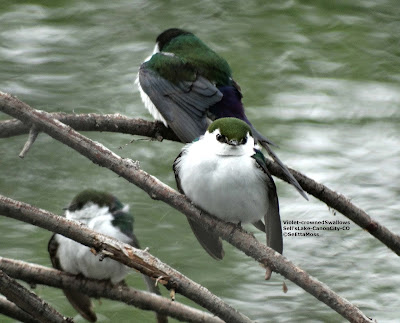Wood Ducks way high up in a tree
[Click on Read More below to see close up pic] While walking on the Canon City Riverwalk a few days ago I was very surprised to spot a Wood Duck perched on a large cottonwood tree at least 70-80 feet above the ground. While I have seen a number of Wood Ducks in trees I have never seen one this high up. As I watched through my binoculars he walked around this large branch then jumped/flew down to a slightly lower branch. After several minutes a second Wood Duck, this one a female, appeared from behind a branch maybe 10-15 feet below the first duck and within a few seconds she flew off followed quickly by the male. Since Wood Ducks do nest in large cavities in trees near water (this location is less than 50 feet from the Arkansas River, see nest site info below), I suspect this is a pair and that the female was house shopping. Maybe since this location is near the Sell's Lake Trailhead and is a very busy area below she decided to look far up above all the human related disturbance. I tried to see if I could see a cavity in the area the female was located but there were too many branches in the way. Just click on pic to enlarge it (but close up pic is below}
Following is what Birds of North America online says about Wood Duck nest sites: "Cavity nester, but does not excavate cavity; instead uses preformed cavities.... Male accompanies female in search of nest cavities, but he plays no role in selection (Grice and Rogers 1965, Bellrose 1976a). Searching is usually done in early morning; male waits nearby while female enters and examines cavity .... Selection may take several days (Bellrose 1976a)." "Cavities average 7.3 m above ground (n = 375, range = 0.6–17.3 m) with higher sites preferred (Soulliere 1990b). " 17.3 meters = about 57 feet, so this female duck was looking at a height of about 55 to 70 feet above the ground, towards the upper limits of their known nesting height. SeEtta Se
Following is what Birds of North America online says about Wood Duck nest sites: "Cavity nester, but does not excavate cavity; instead uses preformed cavities.... Male accompanies female in search of nest cavities, but he plays no role in selection (Grice and Rogers 1965, Bellrose 1976a). Searching is usually done in early morning; male waits nearby while female enters and examines cavity .... Selection may take several days (Bellrose 1976a)." "Cavities average 7.3 m above ground (n = 375, range = 0.6–17.3 m) with higher sites preferred (Soulliere 1990b). " 17.3 meters = about 57 feet, so this female duck was looking at a height of about 55 to 70 feet above the ground, towards the upper limits of their known nesting height. SeEtta Se




Comments